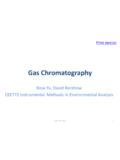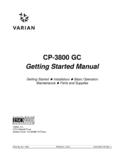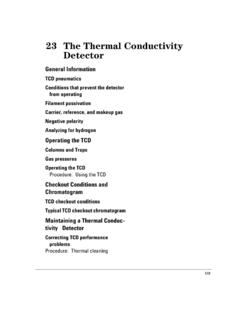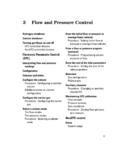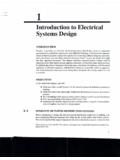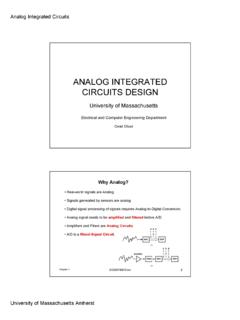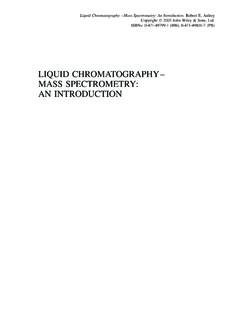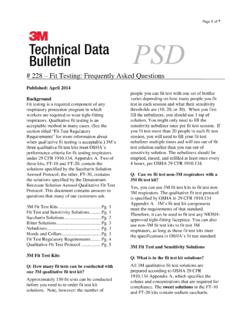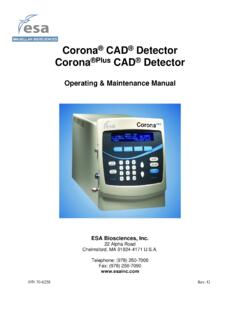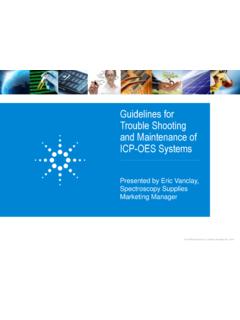Transcription of The Waters Acquity Ultra-Performance Liquid …
1 1 The Waters Acquity ultra -P erformance Liquid chromatograph and the Micromass Quattro Premier Triple Quadrupole Mass Spectrometer Prepared by Yanjun Jiang & Luzal Vaidya December 2012 Section I Introduction An LC/MS/MS is a Liquid chromatograph (LC) system coupled with a quadrupole mass spectrometer (MS). MS quadrupole is the most common mass analyzer, which allows low scan time (<100 ms) and is ideal for LC or GC inlets. When analyzing with LC/MS/MS, the LC separates compounds by conventional chromatography on a column. After the compounds enter the quadrupole mass detector, the solvent is removed and the compounds are ionized. Ions are filtered on the basis of their mass-to-charge ratio (m/z). Ions below and above a certain m/z value will be filtered out depending on the ratio of the direct current (DC) and alternating current (AC) voltages. By ramping the voltages on each set of poles, a complete range of masses can be passed to the detector.
2 Liquid chromatography can separate metabolites that are not volatile and have not been derivatized. As a result, LC/MS can analyze a much wider range of chemical species than GC/MS. Samples commonly analyzed by LC/MS include amino acids (18 out of 20 amino acids can be derivatized, but the remaining two cannot) and sugars larger than trimers. The LC/MS/MS setup has higher compatibility detecting polar compounds such as organic acids, organic amines, nucleosides, ionic species, nucleotides, and polyamines compared to a GC/MS/MS. LC/MS is better suited for a discovery based approach when researching unknown metabolites, or when many of the targeted metabolites GC/MS incompatible due to volatility issues. Advantages of LC/MS/MS: MS provides exceptionally clean product (fragment) ion chromatograms for quantification; Useful for the rapid screening of complex samples where analytes of interest are known; Compound identity confirmation can be achieved with MS/MS using the product ion scan mode; By detecting a specific product ion (precursor ion mode) or charged fragments resulting from a neutral loss (neutral loss mode), a compound of interest can be classified.
3 2 LC/MS/MS Components The LC/MS/MS we used is a Waters Acquity UPLC separation module coupled with a Waters Micromass Quattro Premier XE Mass Spectrometer. (1) UPLC The Acquity UPLC Console contains four major parts: binary solvent manager, sample manager, column manager options, and detector options (Figure 1). Fig. 1 System overview of Acquity UPLC Fig. 2 Schematic of Binary solvent manager Binary solvent manager: Each of the solvent manager s two independent pump systems, A (left) and B (right), contains two linear-drive actuators. Each actuator pair comprises a single reciprocating serial pump that delivers precise flow of a single solvent. The two pump systems combine their two solvents at a filter/tee mixer. From there, the solvent mixture flows to the sample manager (Figure 2). A gradient elution program is commonly used so that the eluent composition (and strength) is steadily changed during the analysis.
4 This increases separation efficiency, decreases the retention time and improves peak shape by minimizing tailing. The chromatography software controls the two solvents mixing ratio by varying the flow of pump A relative to that of pump B. A pressure transducer in each pump head relays pressure to the solvent manager, whose firmware measures pump head pressures during the pumping cycle. Thus the solvent manager independently pre-compresses the solvents in both the A and B portions to ensure consistent solvent delivery and minimize pump-induced detector baseline disturbances. Sample Manager: Plates are transferred in a programmable order from the Sample Organizer to the Acquity UPLC System Sample; Manager for processing plate exchange shuttle replaces a plate in 3 the Sample Manager within 15 seconds to support high sample-throughput processing; It can accept any combination of ANSI-compliant well plates and vial holders.
5 Temperature control is of 4 to 40 C in 1 C increments. The Acquity system also supports a sample organizer which increases the level of automation and sample processing throughput by extending the capacity of the system, by more than tenfold for samples in standard ANSI-compliant 96 or 384 well plates; or more than threefold for samples in conventional 2 mL vials. UPLC Columns: Columns can be divided into two types: Normal phase column and Reverse phase column. Normal phase column: Stationary phase: higher polar rigid silica, or silica-based compositions. Mobile phases: relatively nonpolar solvent. More polar solvent has higher eluent strength and the least polar component is eluted first. Reverse phase column: Stationary phases: nonpolar hydrocarbons, waxy liquids, or bonded hydrocarbons (such as C18, C8, etc.). Mobile phase: polar solvents or mixtures such as methanol- water or acetonitrile- water .
6 Less polar solvent has higher eluent strength and the most polar component is eluted first. Reverse phase columns are more commonly used in UPLC. The Acquity UPLC system also supports a column manager for high-productivity sample processing (Figure 3). It provides automated switching for up to four columns with dimensions up to mm in internal diameter ( ) and 150 mm in length, as well as a bypass channel for flow injections. Fig. 3 An Acquity BEH C18 ( m, X 50 m) UPLC reversed phase column and the schematic 4 Detectors: The system can be configured with in-house optical detectors ( TUV, PDA, or ELS) or connected to a separate Mass Spectrometer. Here MS/MS detector is used and explained in details as follows. (2) MS/MS The Quattro Premier is a high performance tandem quadrupole mass spectrometer designed for routine LC-MS-MS operation. The instrument may be coupled to the following Liquid introduction systems: LC system, to provide molecular weight information from an LC run or to perform target analysis and quantification; Syringe pump, for analysis of precious, low-concentration compounds.
7 The Quattro Premier XE Schematic is shown in Figure 4. Fig. 4 Quattro Premier XE Schematic After a sample is introduced, at atmospheric pressure, into the ionization source and ionized, ions are sampled through a series of orifices , then the ions are filtered according to their mass-to-charge ration (m/z) at the first quadrupole , and the mass-separated ions undergo collision-induced decomposition at the T-Wave Collision Cell , then the fragment ions are filtered according to their mass-to-charge ratio at the second quadrupole , finally the transmitted ions are detected by the photomultiplier detection system and the signal is amplified, digitized , and presented to the control system . 5 MS/MS operating modes are shown in Table 1. The MS1 mode in which MS1 is used as the mass filter is directly analogous to a single quadrupole MS.
8 The MS2 mode of operation is used with collision gas and when switching rapidly between MS and MS/MS operation; it can be useful for instrument tuning and calibration before MS/MS analysis or error checking. The Selected Ion Recording (SIR) mode of operation can also be used as a quantification mode when no suitable fragment ion can be found to perform a more specific analysis. Table 1 MS/MS operating modes (3) Other components Sample Inlet: An HPLC system or an infusion pump delivers sample to either an electrospray ionization (ESI) probe or atmospheric pressure chemical ionization (APCI) probe and serves as the sample inlet. Electrospray ionization (ESI) is an ionization technique where a sample solution is sprayed into a strong electric field in the presence of nitrogen to assist desolvation. The droplets formed evaporate in a region maintained at a vacuum causing the charge to increase on the droplets.
9 The multiply charged ions then enter the analyzer. The most obvious feature of an ESI spectrum is that the ions carry multiple charges, which reduces their mass-to-charge ratio compared to a singly charged species. This allows mass spectra to be obtained for large molecules. Atmospheric pressure chemical ionization (APCI) generally produces protonated or deprotonated molecular ions from the sample via a proton transfer (+ve) or abstraction (-ve). The sample is vaporized in a heated nebulizer before emerging into a cloud of solvent ions formed within the atmospheric source by a corona discharge. Proton transfer or abstraction takes place between the solvent ions and the sample. 6 Vacuum System: An external rotary pump and an internal split-flow turbomolecular pump combine to create a vacuum. The turbomolecular pump evacuates the analyzer and ion transfer region. Data System: The data system collects information from the mass analyzer.
10 The data system consists of: An embeded PC; an external workstation, and the Masslynx software. MassLynx Software: MassLynx software, a Windows based application, enables the following operation: Configuring Quattro Premier XE; Creating inlet and MS methods that define operation parameters for a run; Tuning and calibrating Quattro Premier XE; Running samples; Monitoring the run; Acquiring data. Analysis with LC/MS/MS Analysis with LC/MS/MS can be explained from two respects: (1) Method set-up (containing Mass Spectrometer Method set-up and LC Method Set-up) and (2) Sample analysis. (1) Method set-up Set-up Mass Spectrometer method: Ion source selection: Based on the chemical properties of target compounds, select proper ion source ( , ESI+ve, ESI-ve, APCI+ve, and APCI-ve). Syringe pump injection: Fill the syringe with standard solution of the target compound, using syringe pump for injection. Optimize MS/MS parameters: Steps: (1) ES/APCI Source: Optimize the voltages for ESI/APCI probe, Sample Cone, Extraction Cone and Hexapole; Source temperature; Desolvation and Cone Gas.
